
Buying a used camper can be an excellent way to enter the camping world at a lower price point, and there are a few things you need to watch out for or examine closely to ensure that the camper you get is in good shape.
1. Verify chassis and frame integrity
The most important thing to check when buying a camper is the strength and condition of the chassis, external frame, or whatever the backbone structure of the camper is. If this part of the camper is not in good shape then you need to walk away. Issues here are going to be obscenely expensive (money and time) to fix for the typical person. If you have some fabrication and maintenance skills, you might consider proceeding with caution. Just know that sometimes the hardest part of such a repair is simply getting access to the spots that need help – without breaking everything else. Things to look out for/at: cracks, bent/yielding material, suspension mounts, and corrosion (rust).
2. Check for leaks and water damage
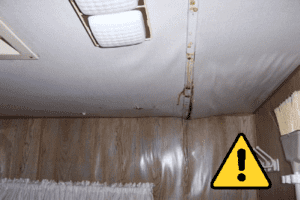
What water damage looks like – Tridelec.com
Water damage can wreak havoc on your camper. It will significantly weaken any wood components or adhesives and lead to material expansion and contraction issues when the water freezes. It is absolutely crucial that you check the camper for any sort of water damage: stains, wet spots, peeling wood, odd smells, cracking, bubbling, or flaking paints.
When you’re in the middle of buying a camper it can be easy to overlook this step and just assume water is not an issue. I urge you to take the extra 30 seconds to inspect every space you can find because this is an important thing to check.
3. Look out for bugs and animals
While it might seem a little pedantic inspecting small nooks and crannies, learning that your new camper has termites living inside, or a spider infestation underneath the mattress is so much worse than being a thorough buyer. While those may be some of the more extreme cases, they aren’t completely unrealistic, and removing bugs is difficult and unpleasant. In addition, if the owner has allowed a bug infestation to occur, there are likely other larger service items that have been neglected. Lift cushions, open cabinets, and inspect every square inch of the camper where bugs may be hiding.
4. Check window, panel, and intrusion seals

Split caulking requires replacement, which means time out of your day and money out of your pocket. – robertssales.com
Inspecting sealed ports goes hand-in-hand with checking for leaks and water damage, though it deserves its own mention because window and panel seals can fail very slowly, so they can go undetectable for quite some time. Take a close look at the sealing interfaces between any windows, fans, and any other potential leak points. You will be rewarded for your diligence. You are looking for dried out butyl tape, cracked or discolored sealants, or even open gaps where there should be a seal.
5. Examine the plumbing and electrical systems
You don’t need to be an electrical professional to make sure the camper you’re buying has good guts.
Even if everything appears to be working, ask to see the electrical panel or box. The organization and quality of the electrical system will tell you a lot about the rest of the camper. This is also a great time to learn about the specifics of the electrical system in case you need to repair it for any reason. Good signs are well organized and labeled connections, properly fastened and insulated wires, heat-shrink electrical connectors, and safe electrical practices. Bad signs are… the opposite of above.
In addition, if the camper has any plumbing make sure to quickly check all water connections, faucets, and drains. You want to figure out any problems with your plumbing before taking possession of the camper to avoid headaches down the road.
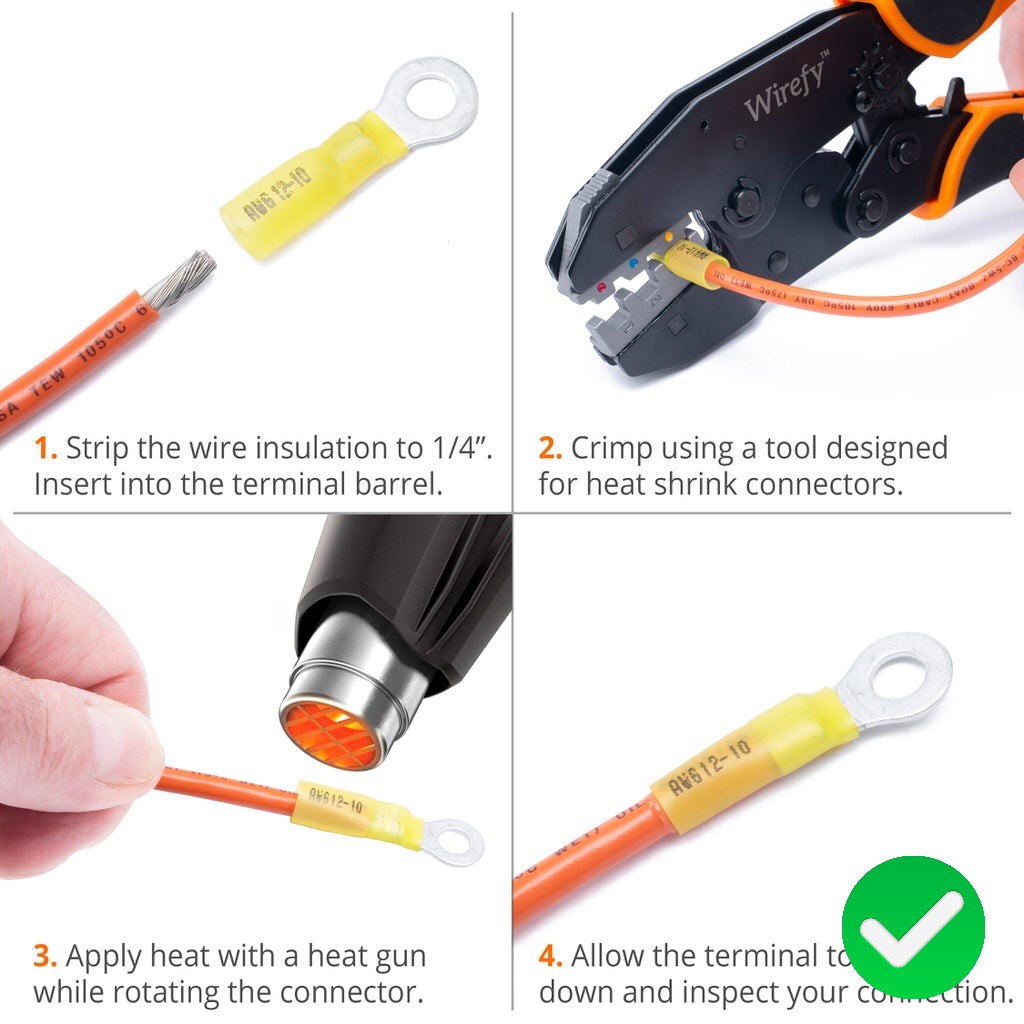
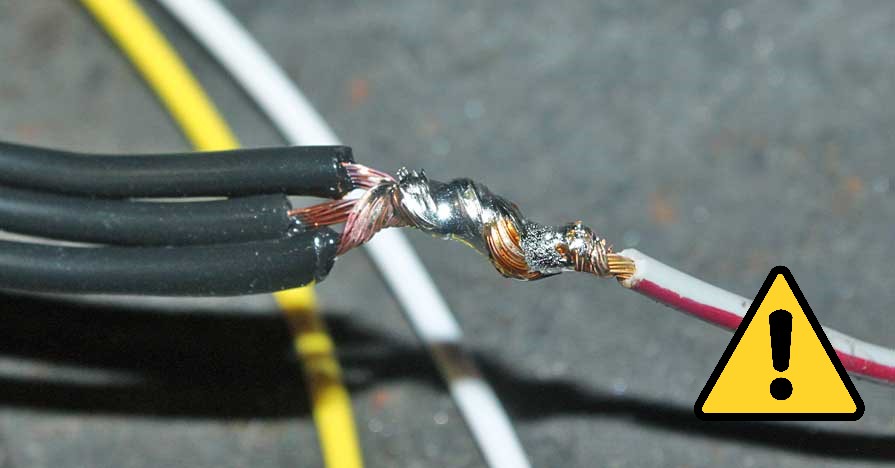
6. Inspect any structural fabric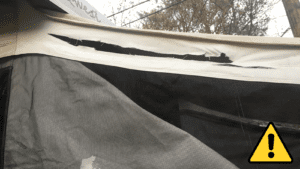
This tip is mostly pertinent to pop-up campers and rooftop tents, but may apply to other types in specific scenarios.
Finding any rips or tears in structural fabric could be game-over for those who are on a budget and do not have the tools to carry out repairs. Duct tape is an acceptable short term repair, but do not expect to solve a problem for the long term this way. It also looks sort of… sketchy? If you find any rips, tears, or weakened portions of structural fabric you will need to consider the potential cost (both time and money) of fixing the issue. That includes stripping down the camper, safely removing the fabric, sourcing repair fabric, getting someone to sew or patch the fabric, and reinstalling. That’s already a lot of steps to have lined up before you have even bought the thing! Look for any rips, tears, stains, or weakened portions of structural fabric.
Note that you can absolutely have fabric repaired professionally, and these things cost money. If you find any such fabric issues, try and negotiate the price down respectively.
7. Evaluate critical mechanical fastener connections

Leaf spring packs can be hiding big problems. Fortunately, they’re easy to check.
The first engaged thread in a 7/8-9 nut typically takes more than 30% of the threaded load (Fastenal). Most campers don’t need that thick of a fastener, but the concept scales with smaller fasteners as well.
This, among other reasons, is a good enough reason to examine the used camper’s important fasteners before purchasing. While many fasteners could fall out and not affect the camper’s performance or safety adversely, there are some crucial locations that should always be examined. Points to check: truck camper tie downs, wheel lugnuts, leaf spring/suspension fasteners, trailer and chassis mount points, spare tire lugnuts, and anything else that could be dangerous if it fell off.
Don’t be the person whose camper fell off in the middle of nowhere.
8. Measure overall camper dimensions
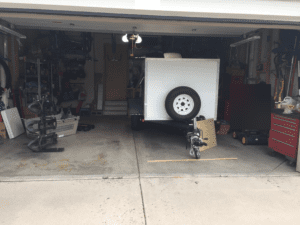
Making sure the camper you’re looking at can actually fit where you need it to is an easy thing to overlook. However, it is not hard to imagine why it is so important that you understand the outer dimensions of the camper you are considering. You’ll need to be able to store, tow, or use the camper in places that have space limitations. Questions you should be asking yourself: “Will this camper fit in my garage or storage area?”, “Can I fit this camper in the places that I want to camp at”?, and “Will this camper fit within the drag zone created by my vehicle?”
9. Current title and registration
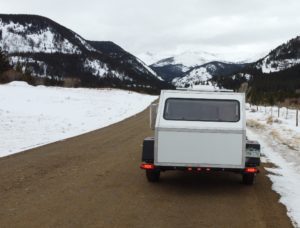
For me it’s “No plate? No deal!”
This advice mostly pertains to RVs and trailers – anything with wheels. Ensuring that the title and registration are current for the camper you are considering purchasing is especially important. Without a title you cannot get a plate for the camper, and thus you cannot legally drive the vehicle on public roads. I strongly encourage avoiding any camper or vehicle that does not have a current and clear title because it is an absolute PITA to try and get a new title. This is an easy question for the seller – just ask the seller for the camper or vehicle’s VIN and look up the VIN on any of the free VIN lookup websites out there on the web.
Buying a camper trailer without a VIN or title can be an acceptable risk in a state that does not tend to enforce registration laws on trailers. However, stay far away from anything with an engine and a missing title. Nearly every time it will be more trouble than it is worth to try and get a title and plate for the vehicle – even if it’s free.
Be extremely wary of any deal where the title is not in the seller’s name, which can indicate that the camper is stolen or part of a tax avoidance scheme. This advice pertains to all other motor vehicles as well.
10. Assess wear items and consumables
If everything else on the camper is in good shape and the package is starting to look like a good buy, then you should assess the status of the camper’s wear items and consumables. What do we mean when we say this? Well, some components such as tires, brake pads, plumbing components, batteries, and propane will either wear out or get consumed with normal use. For example, a great way to get the price down is to point out worn tires or a dead battery. Start this conversation with the seller and you may be able to negotiate your price down quite a bit.
Happy hunting! And as always, feel free to leave a comment or question below or reach out on Instagram, and I will get back to you!

